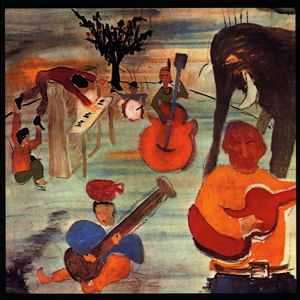Monday, July 28, 2014
Classic Albums: The Band, Music From Big Pink
I am not a fan of fandom. Too many fans identify themselves too closely with their popular culture obsessions, to the point that they get angry at George RR Martin that he doesn't write books fast enough, or take the mediocrity of the Star Wars prequels as a personal affront. I love the stuff I love, but I try to keep my relationship with it healthy.
I try, but don't always succeed. Back in 2011, right after I moved from Texas to New Jersey, my wife and I took an anniversary trip to the Hudson River valley. I insisted that we go on a mission to find Big Pink, the house where members of The Band developed their sound while collaborating with Bob Dylan, who was recovering from a motorcycle accident and general burnout. For me, The Band is the greatest North American rock group of all time, and the famed "basement tapes" recorded in Big Pink some of the deepest, richest music made by Bob Dylan, and certainly the most unique. That house is like a holy site for me, and as we drove through the winding rural roads and into the long driveway, past all of the "No Trespassing" signs, my wife began to (rightly) question what the hell I was doing. I am typically a rule-abider to a fault, but I didn't care, the shrine was too tantalizingly close to turn back. I gazed upon it, snapped a picture, and felt a rush having occupied the same space where something I adored had been created, an experience that every fan craves.
I managed to score a vinyl copy of Big Pink this weekend, and am still amazed at how it just doesn't sound like anything else, including the rest of The Band's output. For a group borrowing heavily from the roots of American music, they refuse to simply recreate that sound. Take their cover of the old school country ballad "Long Black Veil." There's no steel guitar or banjo, but some spooky Garth Hudson organ driving the song. "We Can Talk" features Richard Manuel's great R&B vocal stylings, but the music doesn't really seem to fit any particular genre. Manuel's voice could break your heart, with no better examples than the stunning album opener "Tears of Rage" and on the album closer, "I Shall Be Released." The latter song, with Manuel's haunting falsetto, might be my very favorite interpretation of a Bob Dylan song.
Of course, with The Band it's very difficult to talk about any particular vocalist, since Manuel, Rick Danko, and Levon Helm all sang lead, and on some songs even traded the spotlight. The most famous instance, of course, is "The Weight." That song also showcases The Band's wonderful harmonies, harmonies born out of years of singing together. Unlike most prominent rock bands of the era, The Band had been playing together for years before cutting their first album (under the name The Hawks), first as rockabilly barnburner Ronnie Hawkins' backup band, and later more famously for Bob Dylan when he went electric in 1966. All that familiarity comes out in their music. It is not just evident in the harmonies, but in the interplay between the musicians. Take "Chest Fever" for example, which kicks off with a truly jaw-dropping organ intro from Garth Hudson. Instead of devolving into a prog-rock wank fest, the solo is complimented by Levon Helm's slowly building drums, which have a sublime lightness to them missing from the work of most rock drummers, who just prefer to bash the shit out of the skins.
You could argue (maybe) that The Velvet Underground and Nico is the only album of the late 1960s more influential than Music From Big Pink. Neither album was a commercial hit, but both blew apart the existing rock conventions and spawned many rivers of imitators. In the case of The Band, it imagined music based in the many older forms of American music (jazz, classical, blues, folk, country), but molding them into something completely new and original. As the story goes, Eric Clapton decided to break up his hard blues rock band Cream after hearing Big Pink, thinking Cream's bombastic psychedelia to be played out. That same year, in 1968, the Rolling Stones put their harpsichords and hippie lyrics away and went back to playing gut bucket blues with a big side of nasty. Groups like Fairport Convention toned down the psychedelia and amped up the British folk on records like Liege And Lief.
We live today in a time when creators are pushed to keep churning out new material, to stay on top of ever-shifting trends, and to engage in endless self-promotion. Against this tendency of haste and shallowness, there is no better antidote than Music From Big Pink. It was crafted in an isolated house in the woods by five men who had spent years and years playing in a glorified bar band, perfecting their ability. They were so humble and non-descript that they took for their name The Band, and when they released the album, nobody really knew who they were. Despite all that, they made something that forced other to listen, and even to abandon their old ways. For that reason, and many others, I'm a fan.

I thought you mind find this short essay interesting, comparing music from the Big Pink to Ringo Starr's work on "A Day In The Life"
ReplyDeletehttp://www.heydullblog.com/1960s/1967/happy-birthday-ringo/